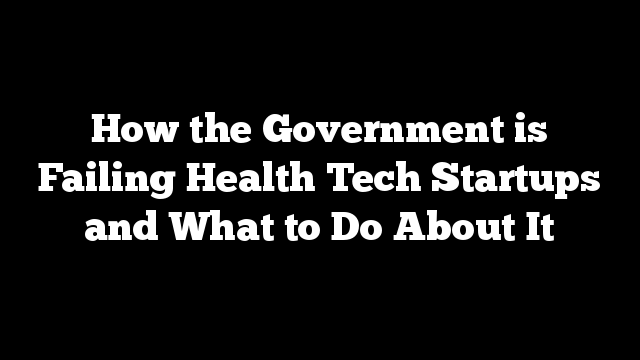
As the Senate debated the fate of the Affordable Care Act (ACA) in Washington this past summer, healthcare was front and center in newspapers and conversations around the country. While insurance coverage and the affordability of care certainly warrant the level of nationwide attention they received, they comprise only one dimension of the systemic deficits in US healthcare: access to care. Meanwhile, the pressing need to reform our broken delivery and payment structures and address the more than $1 trillion of waste in our system was being overlooked by lawmakers in DC.
Luckily, on the other side of the country, entrepreneurs and venture capitalists throughout Silicon Valley are paying plenty of attention to opportunities to improve the efficiency of healthcare. In the first quarter of 2017, while policymakers fought about repeal-and-replace, investors poured almost $1.5 billion into digital health startups (mostly in the San Francisco Bay Area). This is on top of over $29 billion invested in healthcare startups between 2010 and 2016. Many of these budding companies are poised to significantly improve the way healthcare is administered and enhance the experience of providers and patients in novel, tech-enabled ways. Unfortunately, in addition to the myriad barriers facing any new startup, healthcare startups also encounter several unique obstacles rooted in policy failures that severely limit their potential to disrupt a system badly in need of disruption.
I discovered this during a recent stint at a venture capital firm in San Francisco. As a student of health policy and medicine, I’ve studied in depth the systemic problems of access, cost, and quality in American healthcare. After several health policy experiences in Washington, including working in government (at CMS and the Senate) and outside of it (at a think tank), I became acutely aware of the limitations of our political institutions and skeptical that they can solve these problems alone. So, I leaped into the heart of Silicon Valley to get an idea of how the private sector, specifically startups, can push the needle in ways lawmakers cannot.
I quickly became inspired by passionate entrepreneurs, many of them patients or providers themselves, on a mission to fix healthcare. I learned about startups like Blink Health, which has helped millions of Americans, including the under- and uninsured, save money on expensive medications they need but too often cannot afford. Blink is helping patients while also chipping away at systemwide costs for prescription drugs. Here was a company that was achieving the goals of many of my former colleagues in Washington and was doing so in a far more efficient way than the policy initiatives I worked on could. In a similar vein, I learned about Omada Health, which uses digital behavioral counseling to help diabetics, including elderly and underserved patients, lose weight and manage their conditions — another objective of many well-intentioned policy efforts (e.g. Diabetes Prevention Program). As I learned about these courageous companies tackling big, persistent problems and creating social value while disrupting entire sectors within American healthcare, I was filled with hope about what the future holds for a physician-in-training like myself: a better, safer, more sustainable system.
That future depends, though, on the opportunities available to startups across the healthcare ecosystem and the widespread success of at least a fraction of them. Unfortunately, these opportunities are limited by the existing realities of our dysfunctional system and the likelihood of success is often threatened by unnecessary structural barriers. Policy solutions can reform these realities and reduce these barriers, if we can summon the political will. I’ve identified three areas where government has failed health tech startups and avenues by which it can remedy those failures.
Coordination Problems among Electronic Health Records (EHRs)
EHRs have, for years, been at the top of the list of pain points for physicians across the country. Chief among complaints about EHRs is their lack of interoperability — doctors in one hospital often can’t access a patient’s medical records documenting care administered at a different hospital (or other setting). This clearly poses a problem for clinical care, but it also limits opportunities for startups looking to leverage artificial intelligence and data science to support and improve care processes. Since the early days of the HITECH Act, pundits expected the digitization of health records to enable the creation of a comprehensive medical dataset with endless uses. Unfortunately, due to rushed implementation, poor construction, and enforcement of meaningful use criteria, we fell far short of that goal. Furthermore, EHR vendors and providers face market incentives that fly in the face of interoperability — making data and medical records difficult to move between different vendor and health systems helps vendors keep clients and providers keep patients. As a result of these forces, current prospects for de-identifying and conglomerating clinical data across distinct EHR systems nationwide are slim, challenging startups that rely on access to expansive real-world clinical datasets and preventing many teams from even trying.
The failures of the Health Information Technology for Economic and Clinical Health (HITECH) Act are well documented — more important is how we can fix the current state of affairs. Mass coordination problems that are injurious to the public good present an appropriate target for strong-handed government intervention. The HITECH Act pushed interoperability in a limited way and failed to create a market demand for it. To revise this mistake, policymakers ought to, as health IT expert Julia Adler-Milstein puts it, make interoperability “a ‘stay-in-business’ issue for either vendors or their customers.” They can do this by designating it as an imperative in order to sell certified EHR technology and by including carrot-and-stick incentives that offset the market incentives for vendors and providers to drag their feet (e.g. through deliberate “information blocking”). Only then can we construct the comprehensive datasets that would allow startups to mine valuable, cost-cutting, and process-optimizing insights for providers and payers.
Misalignment of Provider Incentives
Dating back to the 1970s, technologists in Silicon Valley and elsewhere have been fascinated with the idea of applying machine learning to healthcare data in order to provide data-driven medical recommendations based on clinical inputs. Over the years, the efficacy of such clinical decision support systems (CDSS) in improving outcomes and promoting evidence-based practice has been demonstrated. However, despite many attempts, they have consistently failed to become a mainstay in American healthcare. CDSSs are a prime example of the type of productive innovation that healthcare providers in the US (including hospitals and individual physicians) do not have an incentive to invest in under their fee-for-service payment structure. As long as we continue to pay doctors based on the number and type of services rendered instead of the quality of that care and the outcomes they produce, startups developing CDSSs and other technologies to improve clinical care will never have tenable business models.
To the federal government’s credit, the ACA and the Medicare Access and CHIP Reauthorization Act (MACRA) are pushing our payment mechanisms away from fee-for-service and towards value-based reimbursement, but we still have a long way to go. While the Quality Payment Program (the implementation of MACRA) is a step in the right direction, the maximum amount of a physician’s income that it will put at risk is 9% of Medicare revenue, which in most cases is too weak an incentive for practices to invest in building or paying for a CDSS. Strengthening such incentives, by placing more Medicare provider revenue at risk through a combination of upside rewards (e.g. shared savings) and downside penalties, will increase the viability of startups looking to build and sell algorithms to enable doctors to make data-driven decisions for their patients.
Lack of Clear Regulatory Guidance in Digital Health
It’s no surprise that digital health startups face a highly regulated market — as they should. New mobile apps and other technologies entering our hospitals and clinics have the potential to seriously impact the course of medical care and ultimately the health of consumers nationwide. However, many startups in this space are encumbered not by regulations themselves but by the lack of clear guidance from the FDA on what types of digital health applications will be regulated and how. For instance, I met an entrepreneur who wanted to build self-triaging functionality into his patient-facing mobile health app to help users make safe, cost-effective decisions about where to seek care. But he and his team decided against it because it’s not clear whether the FDA would regulate that as a class 3 device. His hesitance is shared by many others in the space — some of the most valuable data-enabled functions are seen as too risky to build and sell due to the uncertainty about whether the FDA would require approval.
Over the last few months, we’ve seen early signs that the FDA will clarify these issues and reduce such confusion. Commissioner Scott Gottlieb’s new Digital Health Innovation Plan may deliver the level of specificity in regulatory guidance that startups need to plan effectively. In combination with streamlining the path to market for low-risk digital devices and specifying what digital health tools fall outside the FDA’s scope, these new steps could ease the worries of aspiring entrepreneurs like the one I met. However, as of the end of July, there are still significant gaps in regulatory guidance for the digital health space. The FDA, CMS, and other government agencies need to get ahead of private sector investment to ensure that the enforcement of consumer protections doesn’t slow down innovation. So far, they are failing to even keep pace. Congress ought to hold the administration accountable here and push for clearer and more timely regulatory guidance.
Last week, I attended my first class of medical school. By the time I’m a physician, I think that our healthcare system can be vastly better than it is today. The path to improved outcomes at cheaper costs lies before us. To get there, we need bold policy change and daring entrepreneurs. Too often, the latter are hindered by the lack of the former.
I envision a system where government empowers healthcare startups rather than obstructing them. A system where collaborations between the public and private sector are the driver of progress on cost, access, and quality rather than the source of obstacles. A system where policymakers in Washington and technologists in Silicon Valley work together to transform American healthcare.
Suhas Gondi is a medical student at Harvard Medical School. He can be contacted at suhas_gondi@hms.harvard.edu.
